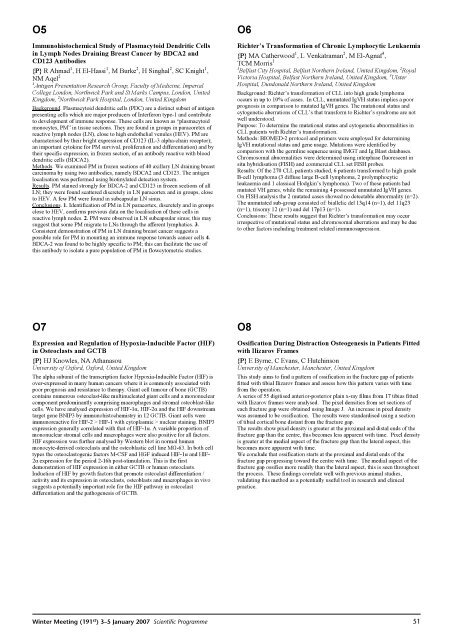2007 Winter Meeting - London - The Pathological Society of Great ...
2007 Winter Meeting - London - The Pathological Society of Great ...
2007 Winter Meeting - London - The Pathological Society of Great ...
- No tags were found...
Create successful ePaper yourself
Turn your PDF publications into a flip-book with our unique Google optimized e-Paper software.
O5Immunohistochemical Study <strong>of</strong> Plasmacytoid Dendritic Cellsin Lymph Nodes Draining Breast Cancer by BDCA2 andCD123 Antibodies{P} R Ahmad 1 , H El-Hassi 1 ,MBurke 2 , H Singhal 2 ,SC Knight 1 ,NM Aqel 21 Antigen Presentation Research Group, Faculty <strong>of</strong> Medicine, ImperialCollege <strong>London</strong>, Northwick Park and St Marks Campus, <strong>London</strong>, UnitedKingdom, 2 Northwick Park Hospital, <strong>London</strong>, United KingdomBackground. Plasmacytoid dendritic cells (PDC) are a distinct subset <strong>of</strong> antigenpresenting cells which are major producers <strong>of</strong> Interferon type-1 and contributeto development <strong>of</strong> immune response. <strong>The</strong>se cells are known as “plasmacytoidmonocytes, PM” in tissue sections. <strong>The</strong>y are found in groups in paracoretex <strong>of</strong>reactive lymph nodes (LN), close to high endothelial venules (HEV). PM arecharacterised by their bright expression <strong>of</strong> CD123 (IL-3 alpha-chain receptor);an important cytokine for PM survival, proliferation and differentiation) and bytheir specific expression, in frozen section, <strong>of</strong> an antibody reactive with blooddendritic cells (BDCA2).Methods. We examined PM in frozen sections <strong>of</strong> 40 axillary LN draining breastcarcinoma by using two antibodies, namely BDCA2 and CD123. <strong>The</strong> antigenlocalisation was performed using biotinylated detection system.Results. PM stained strongly for BDCA-2 and CD123 in frozen sections <strong>of</strong> allLN; they were found scattered discretely in LN paracortex and in groups, closeto HEV. A few PM were found in subcapsular LN sinus.Conclusions. 1. Identification <strong>of</strong> PM in LN paracortex, discretely and in groupsclose to HEV, confirms previous data on the localisation <strong>of</strong> these cells inreactive lymph nodes. 2. PM were observed in LN subcapsular sinus; this maysuggest that some PM migrate to LNs through the afferent lymphatics. 3.Consistent demonstration <strong>of</strong> PM in LN draining breast cancer suggests apossible role for PM in mounting an immune response towards cancer cells 4.BDCA-2 was found to be highly specific to PM; this can facilitate the use <strong>of</strong>this antibody to isolate a pure population <strong>of</strong> PM in flowcytometric studies.O6Richter’s Transformation <strong>of</strong> Chronic Lymphocytic Leukaemia{P} MA Catherwood 1 , L Venkatraman 2 ,MEl-Agnaf 3 ,TCM Morris 11 Belfast City Hospital, Belfast Northern Ireland, United Kingdom, 2 RoyalVictoria Hospital, Belfast Northern Ireland, United Kingdom, 3 UlsterHospital, Dundonald Northern Ireland, United KingdomBackground: Richter’s transformation <strong>of</strong> CLL into high grade lymphomaoccurs in up to 10% <strong>of</strong> cases. In CLL, unmutated IgVH status implies a poorprognosis in comparison to mutated IgVH genes. <strong>The</strong> mutational status andcytogenetic aberrations <strong>of</strong> CLL’s that transform to Richter’s syndrome are notwell understood.Purpose: To determine the mutational status and cytogenetic abnormalities inCLL patients with Richter’s transformation.Methods: BIOMED-2 protocol and primers were employed for determiningIgVH mutational status and gene usage. Mutations were identified bycomparison with the germline sequence using IMGT and Ig Blast databases.Chromosomal abnormalities were determined using interphase fluorescent insitu hybridisation (FISH) and commercial CLL set FISH probes.Results: Of the 270 CLL patients studied, 6 patients transformed to high gradeB-cell lymphoma (3 diffuse large B-cell lymphoma, 2 prolymphocyticleukaemia and 1 classical Hodgkin’s lymphoma). Two <strong>of</strong> these patients hadmutated VH genes, while the remaining 4 possessed unmutated IgVH genes.On FISH analysis the 2 mutated cases showed no detectable abnormality (n=2).<strong>The</strong> unmutated sub-group consisted <strong>of</strong>: biallelic del 13q14 (n=1), del 11q23(n=1), trisomy 12 (n=1) and del 17p13 (n=1).Conclusions: <strong>The</strong>se results suggest that Richter’s transformation may occurirrespective <strong>of</strong> mutational status and chromosomal aberrations and may be dueto other factors including treatment related immunosupression.O7Expression and Regulation <strong>of</strong> Hypoxia-Inducible Factor (HIF)in Osteoclasts and GCTB{P} HJ Knowles, NA AthanasouUniversity <strong>of</strong> Oxford, Oxford, United Kingdom<strong>The</strong> alpha subunit <strong>of</strong> the transcription factor Hypoxia-Inducible Factor (HIF) isover-expressed in many human cancers where it is commonly associated withpoor prognosis and resistance to therapy. Giant cell tumour <strong>of</strong> bone (GCTB)contains numerous osteoclast-like multinucleated giant cells and a mononuclearcomponent predominantly comprising macrophages and stromal osteoblast-likecells. We have analysed expression <strong>of</strong> HIF-1α, HIF-2α and the HIF downstreamtarget gene BNIP3 by immunohistochemistry in 12 GCTB. Giant cells wereimmunoreactive for HIF-2 > HIF-1 with cytoplasmic > nuclear staining. BNIP3expression generally correlated with that <strong>of</strong> HIF-1α. A variable proportion <strong>of</strong>mononuclear stromal cells and macrophages were also positive for all factors.HIF expression was further analysed by Western blot in normal humanmonocyte-derived osteoclasts and the osteoblastic cell line MG-63. In both celltypes the osteoclastogenic factors M-CSF and HGF induced HIF-1α and HIF-2α expression for the period 2-16h post-stimulation. This is the firstdemonstration <strong>of</strong> HIF expression in either GCTB or human osteoclasts.Induction <strong>of</strong> HIF by growth factors that promote osteoclast differentiation /activity and its expression in osteoclasts, osteoblasts and macrophages in vivosuggests a potentially important role for the HIF pathway in osteoclastdifferentiation and the pathogenesis <strong>of</strong> GCTB.O8Ossification During Distraction Osteogenesis in Patients Fittedwith Ilizarov Frames{P} E Byrne, C Evans, C HutchinsonUniversity <strong>of</strong> Manchester, Manchester, United KingdomThis study aims to find a pattern <strong>of</strong> ossification in the fracture gap <strong>of</strong> patientsfitted with tibial Ilizarov frames and assess how this pattern varies with timefrom the operation.A series <strong>of</strong> 55 digitised anterior-posterior plain x-ray films from 17 tibias fittedwith Ilizarov frames were analysed. <strong>The</strong> pixel densities from set sections <strong>of</strong>each fracture gap were obtained using Image J. An increase in pixel densitywas assumed to be ossification. <strong>The</strong> results were standardised using a section<strong>of</strong> tibial cortical bone distant from the fracture gap.<strong>The</strong> results show pixel density is greater at the proximal and distal ends <strong>of</strong> thefracture gap than the centre, this becomes less apparent with time. Pixel densityis greater at the medial aspect <strong>of</strong> the fracture gap than the lateral aspect, thisbecomes more apparent with time.We conclude that ossification starts at the proximal and distal ends <strong>of</strong> thefracture gap progressing toward the centre with time. <strong>The</strong> medial aspect <strong>of</strong> thefracture gap ossifies more readily than the lateral aspect, this is seen throughoutthe process. <strong>The</strong>se findings correlate well with previous animal studies,validating this method as a potentially useful tool in research and clinicalpractice.<strong>Winter</strong> <strong>Meeting</strong> (191 st ) 3–5 January <strong>2007</strong> Scientific Programme51













